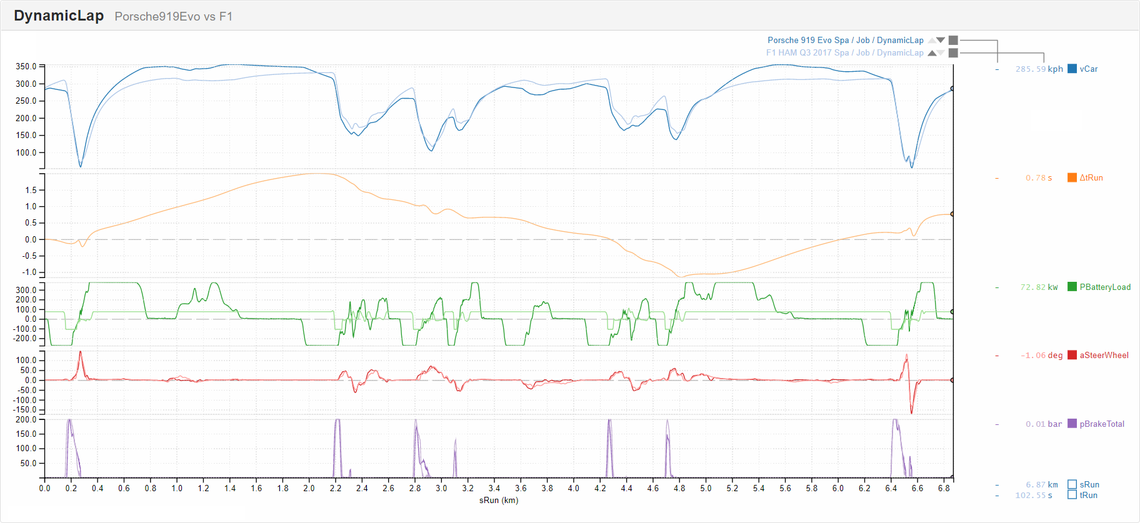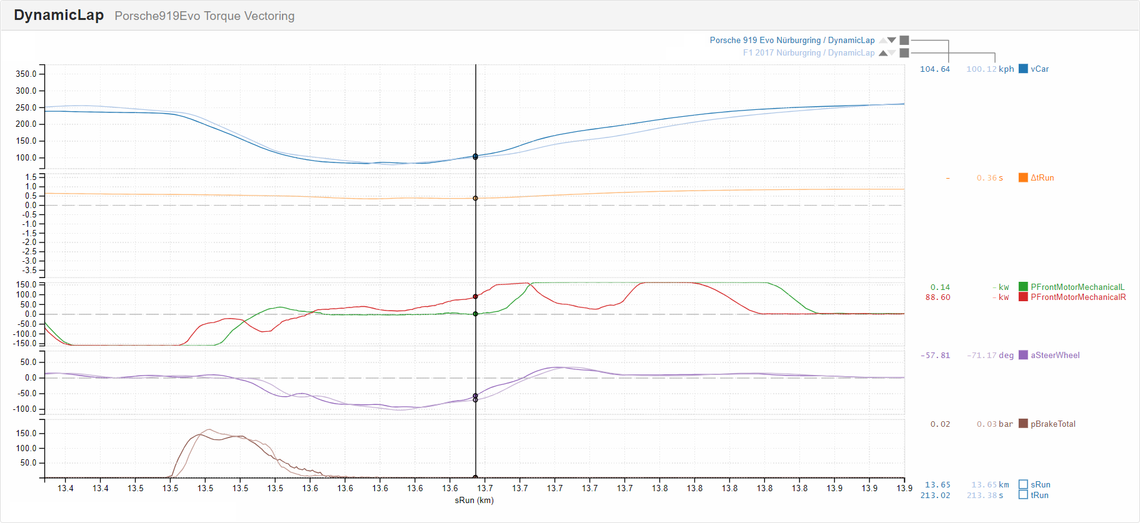F1 vs Porsche 919 Evo at the Nordschleife
AUGUST 8, 2018
Would an F1 car beat the recent lap record around the Nürburgring Nordschleife of 5m19.546 set by the Porsche 919 Evo? We took a look at this question and by using our cloud computing simulation platform we’ve endeavoured to find out!
Starting with our model of the Porsche 919 Evo, we dialled in the correlation to match laptimes, energy deployment and car speed around Spa and the Nordschleife. To match the data at the Nürburgring we needed to drop track grip by 3% and remove 5.3% of the car’s downforce. These changes can be explained by a combination of the following factors:
An actual difference in grip between the two circuits.
Ride heights and suspension have to be raised/softened to compensate for worse track bumps and changes in track camber at the Nordschleife. This causes a reduction in aerodynamic performance.
A reduction in driver confidence around the Green Hell resulting in lower apex speeds than would be theoretically possible.
The generic Canopy F1 car model was tuned, matching it to Lewis’ qualifying lap from Spa 2017. When we bring up an overlay of the Porsche 919 Evo, and 2017 Mercedes F1 car at Spa we can see where the LMP1 car gains and loses relative to the F1 car in order to finish the lap 0.783seconds ahead.

Figure 1: The road to victory around Spa for the Porsche 919 Evo compared to the 2017 Mercedes F1 car.
Right out of Turn 1 we can see the Porsche uses the 440PS on-demand front axle electric motor to good effect when combined with the 720PS V4 engine at the rear to provide all-wheel drive traction, helping it to pull ahead of the Mercedes. Both cars are incredibly quick through Eau Rouge with the Mercedes hitting 316kph through the speed trap, but the LMP1 car manages to stay ahead and keep pulling to a top speed of 359kph on the Kemmel Straight by using its powerful DRS which acts on the rear wing, but unlike F1 can also influence the diffuser aeroflow. At this point things are looking very good for the modified LMP1 car as it has pulled out a massive 2second lead. Toward the end of the Kemmel Straight, the Porsche backs off early to recharge the battery (PBatteryLoad goes negative) in preparation for using the front axle electric motor to accelerate out of the next corner. It generates 40% of it’s electric energy through an exhaust energy recovery system, but the remaining 60% must be generated in the braking zones.
In the second sector, we can see the laptime takes a tumble (∆tRun). While the LMP1 car is super-efficient in a straight line, which makes sense for a car with shrouded wheels which was developed to win on the long straights of Le Mans, it lacks the high overall downforce of the F1 car and can’t match the apex speeds in this twisty section of the track. When we get to the start of the final sector, the Porsche is now 1.2seconds behind.
The Porsche has to claw this time back again in the final sector. Blanchimont is a very high-speed corner, and the LMP1 car can stay flat on the throttle through here, just as the F1 can, but the more efficient aerodynamics package on the Porsche gets it to a higher top speed. In addition, it has the advantage of not being limited to the FIA stipulated DRS zones and can gain an additional straight-line advantage through extra DRS deployment.
Towards the end of the lap, the LMP1 car uses brake regen into the final chicane, of which 80% of the energy collected can be deployed by the all-wheel drive system on the start-finish straight which cements this lead and sees the LMP1 car finish 0.783seconds ahead.
We have seen from Spa that the LMP1 car has incredible straight-line speed, but through tight corners, the Mercedes F1 car has the edge on performance. One could argue that Spa was a wise circuit choice from the team planning to set a lap record, but we shouldn’t take this away from them. The Porsche has incredible energy management, and it uses the 8.49MJ of electrical energy that it recovers intelligently around the circuit to help it boost acceleration performance.
Now back to the question in hand though, which car would win around the Nordschleife? To answer this, we have two options; my preferred being for an F1 team to attempt this record as a marketing exercise. Failing that we must use a powerful laptime simulation that can solve for optimal energy deployment, active aero, clever torque vectoring and racing line optimisation.
Applying the same 3% drop in grip and 5.3% downforce to the F1 car as required for correlation with the Porsche 919 Evo gave the following result around the Nordschleife:

Figure 2: An extremely close match in performance between the modified LMP1 car & 2017 F1 car around the Nordschleife.
Taking everything that we can into account with the simulation, the headline result is that the 2017 Mercedes F1 car could get around the Nürburgring in 5m17.549, which is around 2seconds quicker than the Porsche 919 Evo. We can draw similar conclusions to Spa; the F1 car gains through tight corners, while the LMP1 car has a significant straight-line advantage. The LMP1 car manages to stay ahead until the Carousel at 13.5km in, but a series of tight and twisty corners from here to the main straight allows the F1 car to overtake and open up a lead of 3.9sec. The LMP1 car claws this back to just 2sec in the long sprint to the finish line, but this isn’t enough.
In theory we have our answer, the F1 car should be quicker, but in practice due to a variety of reasons it’s much too close to call. If we compare the Mercedes teammates in Spa 2017, they were 0.541sec apart in Q3 using very similar machinery. Spread this out over a longer, much less forgiving circuit, and we would expect the gap between drivers to exceed 1.7sec.
On top of this driver difference, we should consider the drivability of the machines i.e. how easily the drivers can consistently push out fast laptimes close to the limit. Lap simulations assume perfect driver performance, when this isn’t likely to be the case for a 21km circuit with 154 turns. Without being bound by the regulations, the team at Porsche have implemented torque vectoring. This allows power to be sent to the outside wheels in order to help turn the car. Combined with the all-wheel drive system, one might expect the Porsche 919 Evo to be more forgiving when it comes to a small driver mistake, allowing the car to steer around a slightly different line in order to get back on course.

Figure 3: Torque vectoring at the Carousel: more power supplied to the front outside wheel (PFrontMotorMechanicalR) to turn the car. Could this make all the difference when it comes to drivability?
Another consideration is how well the teams prepare for the record. Porsche are accustomed to setting fast times at the ‘ring, with excellent technical facilities; while it’s been several decades since F1 teams were racing around here. We’ve assumed that the F1 car will respond similarly when it comes to grip and downforce while making setup changes for the ‘ring, but this might not be true, and one of these cars might have better ride performance which would prove to be advantageous.
To further muddy the waters, F1 cars are quicker this year than last, and who knows what tricks an F1 team might come up with if they weren’t bound by the regulations. It’s too close to call from simulation, but if I had to make a guess I think the Porsche might just be ahead of the F1 field when it comes to delivering a complete package at the Nordschleife.
If you’re interested in setting a Nordschleife lap record and would like to know more about how our sims could help you dial in your performance, then this article takes a look at setup for front, rear and all wheel drive cars at the Nordschleife.